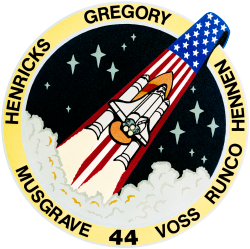Mission highlights
| Attempt | Planned | Result | Turnaround | Reason | Decision point | Weather go (%) | Notes |
|---|
| 1 | 19 Nov 1991, 6:51:00 pm | Scrubbed | — | Technical | 19 Nov 1991, 10:00 am (T−09:00:00) | | Inertial measurement unit malfunction on IUS. |
| 2 | 24 Nov 1991, 6:44:00 pm | Success | 4 days 23 hours 53 minutes | | | | T−9 minute hold extended for 13 minutes to fix a leaking Liquid Oxygen replenish valve and allow an orbiting spacecraft to pass over the launch site. [3] |
The launch was on November 24, 1991, at 23:44:00 UTC. A launch set for November 19, 1991, was delayed due to replacement and testing of a malfunctioning redundant inertial measurement unit on the Inertial Upper Stage (IUS) booster attached to the Defense Support Program (DSP) satellite. [4] The launch was reset for November 24 and was delayed by 13 minutes to allow an orbiting spacecraft to pass and to allow external tank liquid oxygen replenishment after minor repairs to a valve in the liquid oxygen replenishment system in the mobile launcher platform. Launch weight was 117,766 kilograms (259,630 lb). [3]
The mission was dedicated to the Department of Defense. The unclassified payload included a Defense Support Program (DSP) satellite, DSP-16 attached to Inertial Upper Stage (IUS-14), deployed on flight day one. Cargo bay and middeck payloads included the Interim Operational Contamination Monitor (IOCM), Terra-Scout, Military Man in Space (M88-1), Air Force Maui Optical Site (AMOS), Cosmic Radiation Effects and Activation Monitor (CREAM), Shuttle Activation Monitor (SAM), Radiation Monitoring Equipment (RME III), Visual Function Tester (VFT-1), Bioreactor Flow, and Extended Duration Orbiter Medical Project, a series of investigations in support of Extended Duration Orbiter. The Ultraviolet Plume Instrument (UVPI) experiment was located onboard the previously-launched LACE satellite, and could've been pointed at Atlantis on-orbit to observe the shuttle's thruster firings. However, no opportunities or intersections occurred during this mission. [5]
The landing was on December 1, 1991, at 22:34:44 UTC, Runway 5, Edwards Air Force Base, California. The rollout distance was 3,411 m (11,191 ft), and the rollout time was 107 seconds. The landing weight was 87,918 kg (193,826 lb). The landing was originally scheduled for Kennedy Space Center on December 4, 1991, but the ten-day mission was shortened and the landing rescheduled following the November 30, 1991, on-orbit failure of one of three orbiter inertial measurement units. [6] The lengthy rollout was due to minimal braking for test. Atlantis returned to Kennedy on December 8, 1991. This was also the final shuttle landing on a dry lake bed runway.
This page is based on this
Wikipedia article Text is available under the
CC BY-SA 4.0 license; additional terms may apply.
Images, videos and audio are available under their respective licenses.




